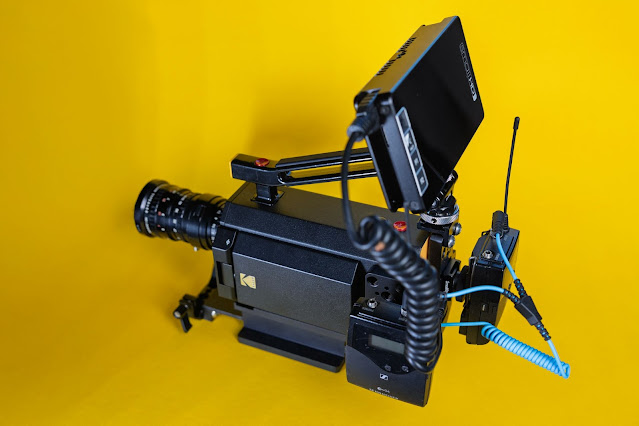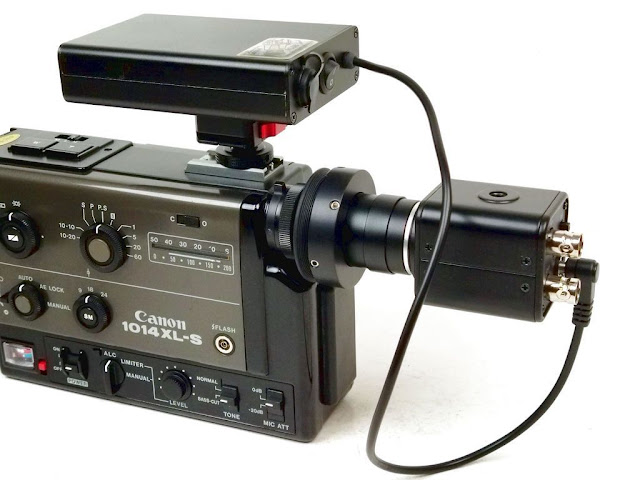Todos mis lectores saben que, desde antes de ir a la universidad en mi querida Barcelona, hace medio siglo, soy un firme defensor del sistema Single-8. La película y el formato es el mismo que el Súper-8: película de 8 mm con perforaciones tipo S. La diferencia está únicamente en la presentación: el cargador de Súper-8 es coaxial con un solo eje, mientras que el de Single-8 tiene dos ejes (de forma que se puede filmar marcha atrás en toda su integridad, o rebobinar), es recargable, no lleva presor (sino que incluso las cámaras mas baratas para este tipo de cartuchos, llevan su propio presor metálico) y, muy importante, el arrastre de la película es por debajo de la ventanilla, “tirando” de la película, como todos los pasos de cine, excepto el Súper 8, en que la uña de arrastre se encuentra por encima de la ventanilla, y “empuja” la película hacia abajo. Toda esta serie de factores motivan que, filmando con cartuchos de Single-8, la estabilidad de la imagen sea superlativa y que los cartuchos nunca se atasquen.

Por otra parte, el Single-8 permite filmar "con la mejor cámara de 8 mm jamás fabricada" (Ivan Watson dixit): la nunca suficientemente ponderada Fujica ZC1000N, que me ha acompañado desde los desiertos africanos hasta el corazón mismo de la Antártida, en trabajos profesionales durante medio siglo, sin la menor falla en todas estas décadas. La ZC1000N tiene doble sistema de obturador variable, contador digital de fotogramas, montura tipo C, 72 fotogramas por segundo, motor exterior de exposición lenta y, entre otras golosinas técnicas, arrastre con garfio de dos uñas después de la ventanilla y un segundo garfio antes de la ventanilla para filmar marcha atrás la totalidad del cartucho sin variación en la línea de encuadre.

Pese a todas estas ventajas, el single-8 nunca obtuvo la popularidad que se merecía (excepto en el Japón y Holanda), por una razón: la ausencia de disponibilidad de la mejor película, el Kodachrome (al menos, para el gran público, no para mi, que filmé Kodachrome en Single-8, recargándome yo mismo los cartuchos que enviaba a revelar a Dwayne’s. Tengo que puntualizar, sin embargo, que el Fujicolor disponible entre 1965 y 1973 es casi tan bueno e inmune al desvanecimiento como el Kodachrome y que el Fujichrome tipo N, fabricada entre el año 2000 y 2012 es de altísima calidad).
Filmando, pues, toda mi vida en cartuchos de Single-8, la llegada del libro de Jürgen Lossau y Samuel Preston SINGLE-8 STORY, presentado en inglés y alemán simultáneamente, ha colmado todas mis espectativas: abundante información nunca antes publicada, excepcionales ilustraciones y una muy buena calidad de impresión en un volumen de gran formato.
El libro se encuentra dividido en varias secciones, con textos de gran interés, como las diferencias que hay entre la ZC1000 normal, fabricada entre 1974 y 1979, y la mejorada ZC1000 New, producida entre 1979 y 1982, con una montura C, de bronce, reforzada para admitir objetivos de mucho peso, entre otras prestaciones. Con este libro, el neófito podrá distinguir a primera vista entre ambos tipos de ZC1000. Por supuesto, esta cámara se muestra muy bien estudiada.
La obra Lossau pasa revista, pormenorizadamente, a cada una de las cámaras de Single-8 producidas e, incluso, dedica un capítulo a informar de las fechas de publicación de cada cámara de Single-8, y no sólo de Fujifilm, sino también de otros fabricantes como Canon, Elmo o Konica.
Una investigación profunda analiza como se gestó el sistema de Single-8, en 1959, y las vicisitudes que tuvo que vivir hasta llegar al mercado en 1965. Otro capítulo relata la asombrosa cámara Fujica ZS400 que permite registrar sonido óptico con cualquier cartucho de Single-8 mudo. Una de las partes mas interesantes es la entrevista que, recientemente, Tak Kohyama hizo a Shigeo Mizukawa, diseñador de la ZC1000, entre otras cámaras de Fuji. Conozco a Shigeo personalmente. Por eso, me encanta que se acuerde de mí cuando dice: "Ignacio Benedeti rueda sus documentales en todo el mundo con la ZC1000 con película Kodak cargada en cartuchos de Single-8. Su cámara jamás dejó de funcionar, en cincuenta años, incluso en las bajas temperaturas de la Antártida".
También, me emociona que el maestro Kohyama, al que conozco desde hace mas de un cuarto de siglo, comente: "Ignacio Benedeti ha estado filmando con la ZC1000 desde hace casi medio siglo. Siempre admiré sus proyectos cinematográficos, por lo que yo mismo compré una ZC1000"
Una sección final del libro reproduce folletos que, a lo largo de los años, ha editado Fujifilm para promover y mantener el sistema, en una labor encomiable que mantuvo entre 1965 y 2014.
 |
| Escribí esta reseña mientras cuido de mi madre de 92 años, delicada de salud |
El libro "Single-8 Story" es fundamental en la biblioteca de cualquier entusiasta del cine en pequeño formato. Su compra es la mejor inversión que he hecho este 2025 para mi biblioteca pues, estoy seguro, que lo releeré muchas veces en los años que vengan.
El libro se puede comprar a través del siguiente enlace: https://www.super8mag.de/shop/




















































